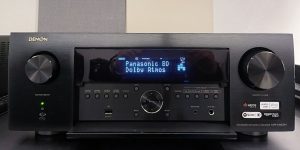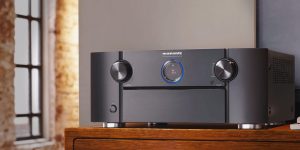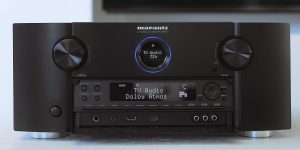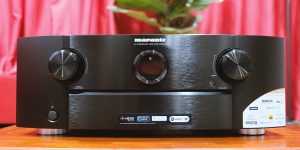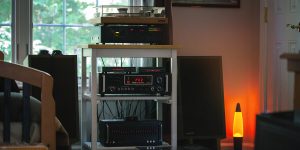You probably know the importance of having the right AV receiver to power your home system. It is the central hub that connects all your devices and sends audio and video signals to your speakers and display. Of course, choosing the right one can be daunting with so many options on the market. That’s why I did some testing and research to find the best Onkyo receivers currently available. In this article, I’ll take an in-depth look at the different Onkyo models, and you and I will see how they perform in terms of features, sound quality, and ease of use. So, if you want to improve your home theater experience, let’s dive in and find the perfect Onkyo receiver.
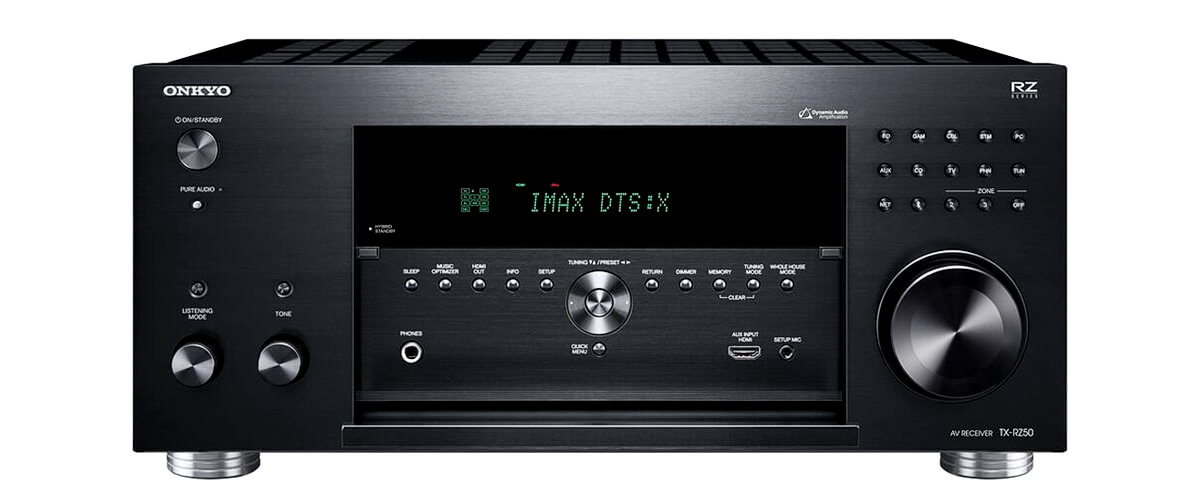
Onkyo receivers comparison table
| Name | Channels | Power output | HDMI in/out | Bluetooth/Wi-Fi | Review |
|---|---|---|---|---|---|
| Onkyo TX-RZ50 best overall | 9.2 | 120W/8 Ohms | 7/2 | yes/yes | Review |
| Onkyo TX-SR393 budget | 5.2 | 80W/8 Ohms | 4/1 | yes/no | Review |
| Onkyo TX-RZ70 premium | 11.2 | 140W/8 Ohms | 7/3 | yes/yes | Review |
| Onkyo TX-8260 stereo | 2.1 | 80W/8 Ohms | 0/0 | yes/yes | Review |
Brief history of Onkyo
Onkyo is a Japanese brand that has been producing high-quality audio equipment for over 75 years. The company was founded in 1946 by Takeshi Godai in Osaka, Japan, and started out producing turntables and tonearms. In the following years, Onkyo expanded its product line to amplifiers, receivers, and speakers, becoming one of Japan’s leading audio equipment manufacturers.
Over the years, Onkyo has gained a reputation for producing reliable products. The company has many fans worldwide who appreciate its products’ sound quality and performance. Onkyo has received numerous awards and accolades for its products, including several Best Buy awards from Consumer Reports.
Is Onkyo still in business?
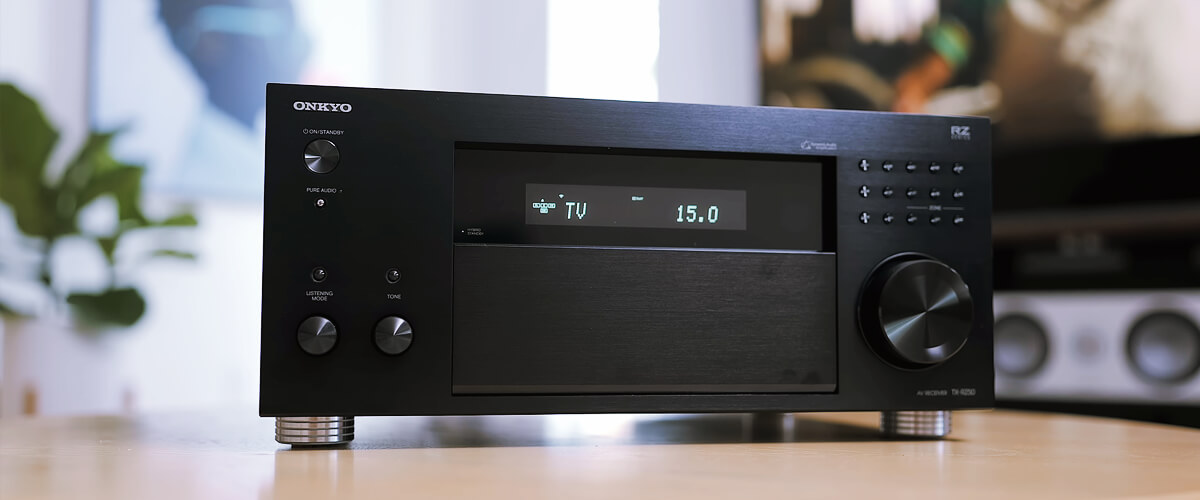
In recent years, Onkyo has faced some challenges, including bankruptcy and a change of ownership. Despite these difficulties, the company continues to produce audio equipment, including some of the newest Onkyo receivers.
In 2022, Onkyo announced that it would continue as a major audio brand thanks to a partnership with a premium audio company, Sharp. The partnership will allow Onkyo to continue developing and producing high-quality units while benefiting from Sharp’s expertise in the electronics industry.
Despite its challenges, Onkyo remains a respected brand in the audio industry, and enthusiasts and professionals alike still seek after its receivers. Onkyo continues to produce some of the highest audio equipment available, including some of the newest Onkyo receivers that feature the latest technology and features to enhance the home theater experience.
Best Onkyo receiver reviews
Onkyo TX-RZ50 – best overall

The company released its Onkyo TX-RZ50 receiver in 2021 as a flagship model. And this is the one I want to start my list with. This AVR boasts several distinctive features that set it apart from its predecessors, including an updated design and the use of premium materials in its construction. I recommend the Onkyo TX-RZ50 to anyone serious about home theater and willing to invest in a fairly reasonable value for the mid-priced range.
So, what we have before us is a 9.2-channel receiver. Considering this model, you can compare it with another 9-channel model Onkyo TX-NR7100. The main difference between the two is that the TX-RZ50 can be expanded to an 11.2 system (it has pre-outs for 7.2.4 systems), giving you even more options for your home theater experience. And it delivers a solid 120W (8 ohms, 20Hz – 20kHz, 0.08% THD, 2 ch), so it’s the most powerful Onkyo receiver. In my opinion, this is more than enough to shake you up during intense movie scenes or while listening to your favorite tunes.
The TX-RZ50 also offers some advanced features and technologies. You’ll find 6 HDMI inputs and 2 HDMI outputs in this model, all of which support HDMI 2.1, perfect for today’s home theaters. It also has HDMI eARC, CEC, and HDCP 2.3, making it compatible with the latest devices. In addition, there is a phono input for the turntable and two outputs for the subwoofer. Finally, if you’re working with older equipment, it’s nice to know that you can still connect them to this receiver.
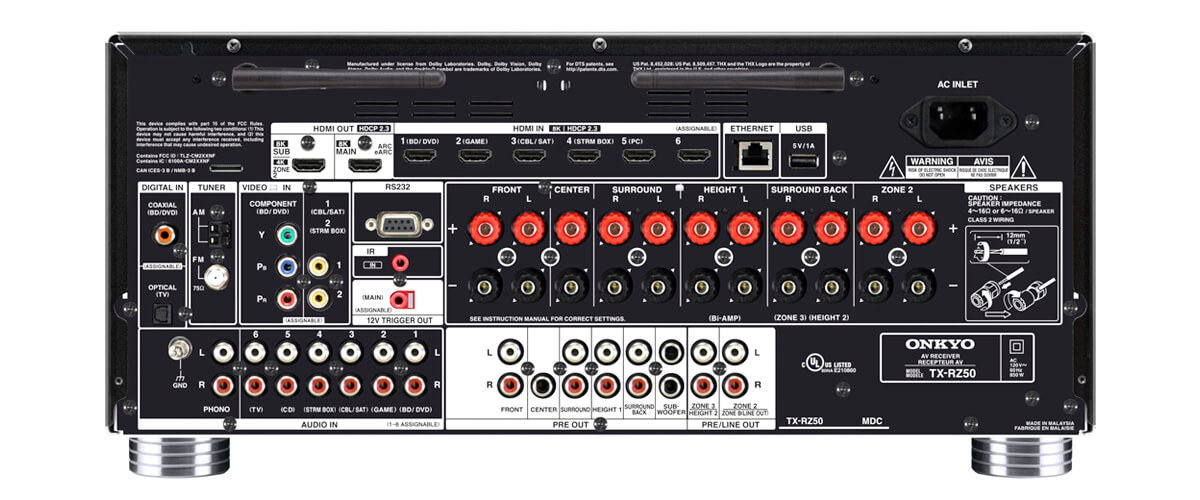
Wireless connections? The TX-RZ50 takes care of that. It supports Wi-Fi and Bluetooth and has popular streaming services Spotify, Tidal, and Deezer built into its system. If you like voice assistants, you’ll be happy to know that it’s compatible with Amazon Alexa, Google Assistant, and Apple Siri (but you have to buy a special device).
Now for the video features. The TX-RZ50 supports 8K/60Hz (for zone 1 only) and 4K/120Hz (for zone 1 and 2), making it great for watching content in HDR quality. Audio can be broadcast to 3 zones.
When it comes to surround sound formats, the TX-RZ50 does not disappoint. The AVR supports DTS:X immersive audio formats, IMAX Enhanced, and THX Certified Select. And with AccuReflex’s Atmos-enabled speaker phase-matching solution, you can sufficiently view features with a Dolby soundtrack as well.
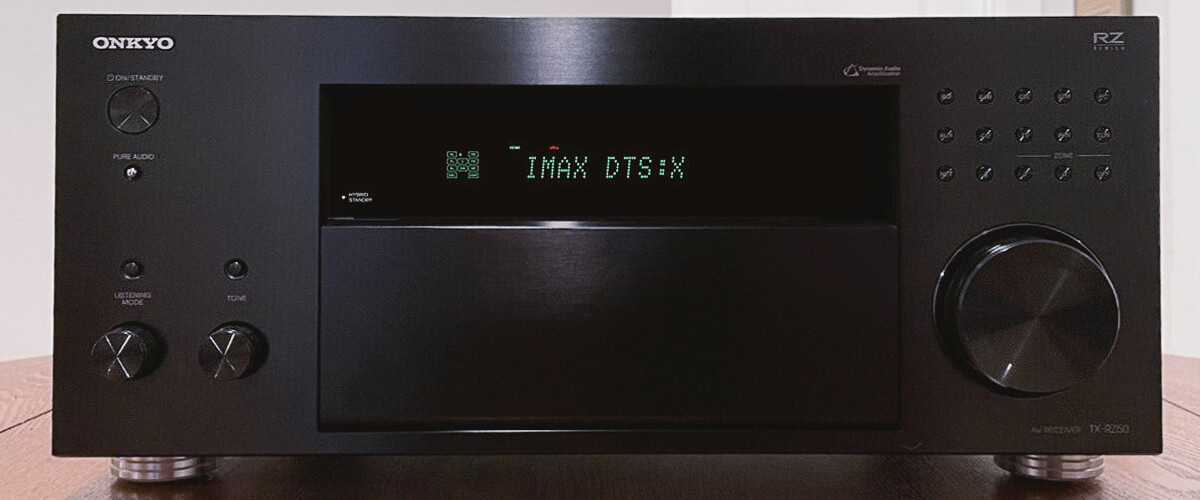
Regarding multi-room broadcasting, in addition to zoning, multi-room audio is provided with MusicCast and a Sonos connection port. As for the Dirac Live Room Correction calibration, the creators went a little overboard. Everything works fine, but I encountered a rather complicated setup process that will probably seem like some sort of Abra-Cadabra to many users. But it’s possible, folks! You can do it.
So how does it sound? During testing, I watched various movies and TV shows with the TX-RZ50, and I must say that the receiver provided excellent detail, and I could hear even the subtlest nuances in the sound mix. For example, while watching the movie Inception, the dialogues were clear, even during tense events. In addition, the treble was crisp, the mids were well-balanced, and the lows were seriously punchy.
For the combination of functionality (it’s not overpowered, but has everything I need to work for years to come) and cost, I give it the title of best Onkyo receiver on my list.
Specifications of Onkyo TX-RZ50
- Channels: 9.2.
- Output power: 120W/8 Ohms.
- HDMI inputs/outputs: 7/2.
- Surround sound
- Dolby features: Dolby TrueHD, Dolby Atmos Height Virtualizer, Dolby Atmos, Dolby Surround.
- DTS features: DTS HD Master, DTS:X, DTS Neural:X.
- IMAX Enhanced.
- Video
- Video functions: 4K/120Hz, 8K/60Hz pass-through, upscaling to 8K.
- Video support: HDMI ARC, HDMI eARC, HDMI CEC, HDCP2.3, HLG, HDR10, HDR10+, Dolby Vision.
- Bluetooth/Wi-Fi: yes/yes.
- Streaming service: AirPlay2, Spotify, Deezer, Tidal, Pandora, SiriusXM, Napster, SoundCloud, Amazon Music HD, TuneIn.
Pros
- High power.
- Expandable to 11.2 configuration.
- Support for advanced surround sound formats.
- The ability to stream audio and video to 2 zones.
Cons
- You may encounter difficulties in the setup process; the process is a bit complicated.
Onkyo TX-SR393 – budget

The Onkyo TX-SR393 is the best budget Onkyo AV receiver on my list that the company released in 2019. It may not be as advanced as the TX-RZ50 or even the TX-NR6050 (which I’ll review later), but it still has much to offer. This 5.2-channel receiver is great for small rooms and delivers a solid 80W per channel (8 ohms, 20Hz – 20kHz, 0.08% THD, 2 ch), which in my opinion, is enough to enjoy high-quality sound and intense movie scenes, especially for a little space.
The TX-SR393 has a limited number of HDMI inputs, which for someone, may be the deciding factor (as it was for me). It has 4 HDMI inputs and 1 output. However, it’s worth noting that their configuration makes up for the small number. The ports support HDCP 2.3, 3D, ARC, and CEC so that you can transmit high-quality and lossless video and audio. Another drawback for me is the fact that the receiver doesn’t have phono input for turntables, so you have to use an external preamplifier if you, like me, can’t live without vinyl. But the receiver supports Bluetooth, which allows you to stream music wirelessly from your phone or popular streaming services.
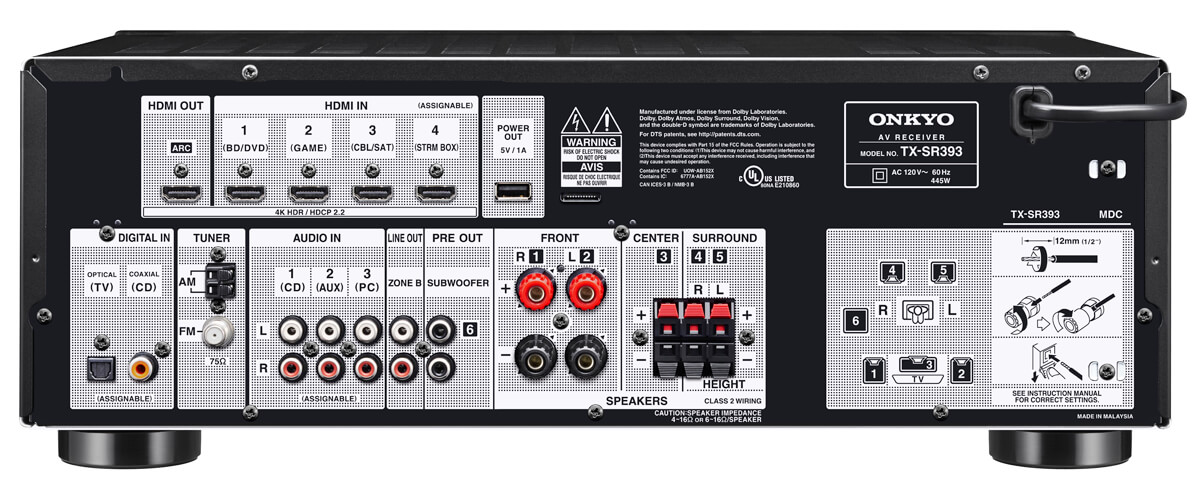
Based on the HDMI port options, you get a state-of-the-art device that supports 4K/60Hz video, 4:4:4 color space, and enjoy HDR (High Dynamic Range) video, including HDR10, HLG, Dolby Vision, and BT.2020. In addition, you can enhance the resolution of older content from 1080p to 4K and get the 4K pass-through option. I’m a big fan of audio, so this data is quite satisfying to me.
5.1 is the minimum configuration for surround sound. Still, with this receiver, you have Dolby Surround and DTS Neural:X, which find the top signals in older soundtracks, and you can use Dolby Atmos Height Virtualizer to play the upper channels. It doesn’t give you a full display of the soundscape, but it will be a great help for the unsophisticated viewer.
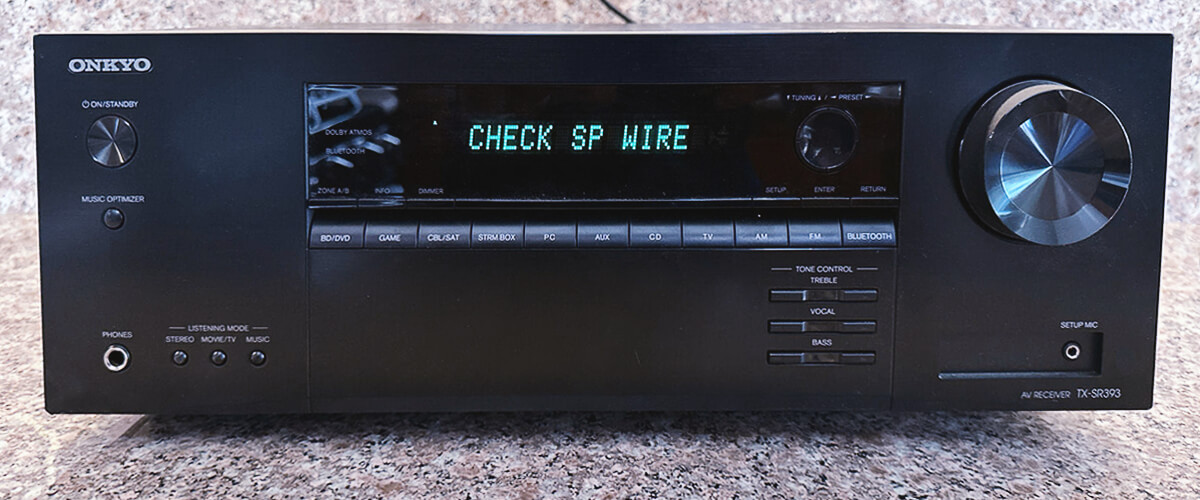
This simple receiver, unlike the TX-RZ50, features AccuEQ acoustic room calibration technology, which is much easier to set up. I tested the Onkyo TX-SR393 with the classic drama The Godfather. The sound of the music was rich and detailed, conveying the characters’ emotions on screen. The accurate and precise sound reproduction made me feel like I was transported back in time to the world of Corleone.
Onkyo TX-SR393 is a budget AV receiver with good features and functions for its price range, making it a versatile choice for home theater, even though it does not have all the “bells and whistles” inherent in more expensive models.
Specifications of Onkyo TX-SR393
- Channels: 5.2.
- Output power: 80W/8 Ohms.
- HDMI inputs/outputs: 4/1.
- Surround sound
- Dolby features: Dolby TrueHD, Dolby Atmos Height Virtualizer, Dolby Atmos, Dolby Surround upmixing.
- DTS features: DTS HD Master, DTS:X, DTS Neural:X upmixing, DTS Virtual:X.
- Video
- Video functions: 4K/60Hz pass-through.
- Video support: HDMI ARC, HDMI CEC, HDCP2.3, HLG, HDR10, Dolby Vision.
- Bluetooth/Wi-Fi: yes/no.
- Streaming service: has not.
Pros
- HDMI ports support HDCP 2.3, 3D, ARC, and CEC.
- Bluetooth connectivity.
- Easy setup.
- Supports popular quality video formats.
Cons
- Sufficient output power for a small room only.
- Fewer HDMI inputs than other models.
Onkyo TX-RZ70 – premium
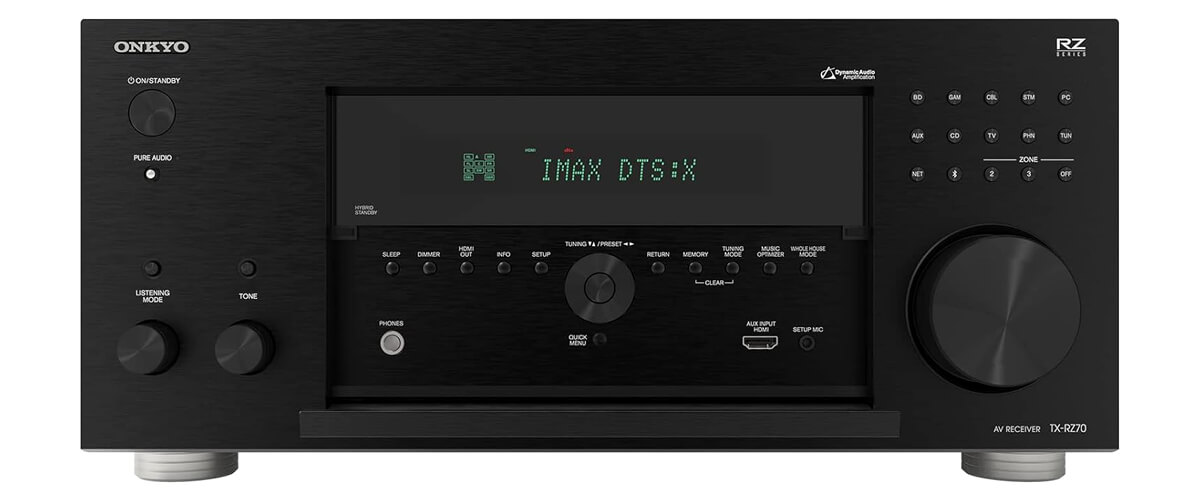
Well, if in the previous review, we talked about the budget receiver from Onkyo, in this review we will discuss the premium model. If I were asked to characterize it in one word, I would say, “WOW!”. Now, I will tell you more about why I decided so and why I consider this device a real competitor for Denon and Marantz.
This 11.2-channel flagship AV receiver from Onkyo can provide Class AB amplification for all 11 of its channels, delivering 140 watts each – that’s to 8-ohm speakers. The massive transformer is separated from other circuitry and shielded. Audio signal processing is realized by two 32-bit ESS DACs. By the way, I would like to point out one interesting fact. TX-RZ70 was developed by Onkyo Japan and Premium Audio Company, subsidiaries of Voxx International, which, besides Onkyo itself, owns Klipsch and the rights to Pioneer in home entertainment. That’s why I assumed that the sound would pleasantly surprise me. But more on that later.
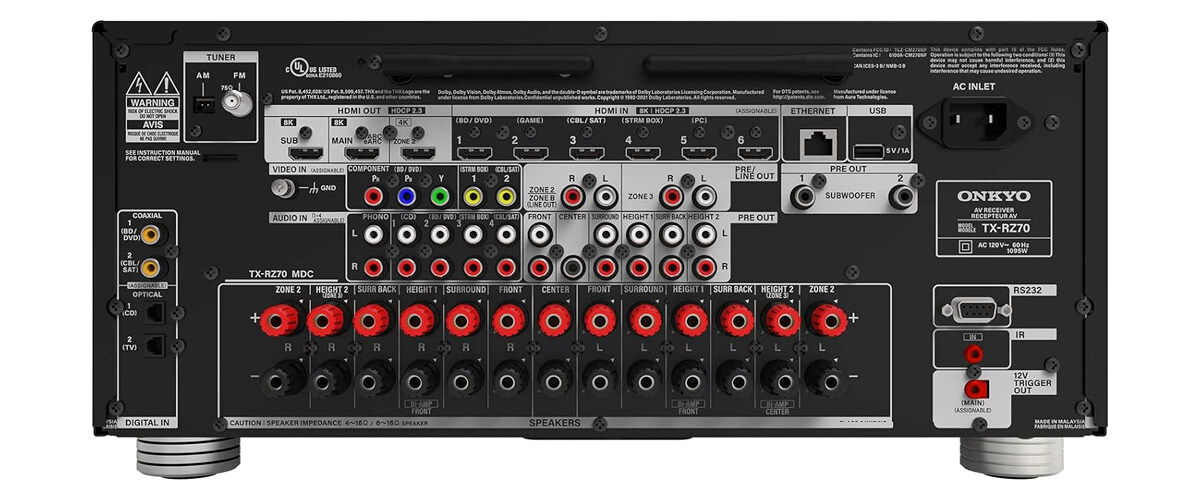
A few words about the design. Nothing new, a usual rectangular box, but finally, there is a large and easy-to-read display. I can see all the inscriptions perfectly, and it is as informative as possible. Besides, there are quite a lot of controls on the front panel, which I personally like very much.
As for supported formats and technologies, there is everything or almost everything. Streaming technologies are fully represented in TX-RZ70. The receiver is also compatible with Sonos equipment. Available voice assistants are Google Assistant, Alexa, and Siri. Of course, there is support for Dolby Atmos, DTS:X, IMAX Enhanced, and Auro 3D. 6 of the TX-RZ70’s 7 HDMI eARC inputs (one front) are 8K compatible, and there are three HDMI outputs. All of them support HDMI 2.1/HDCP 2.3.
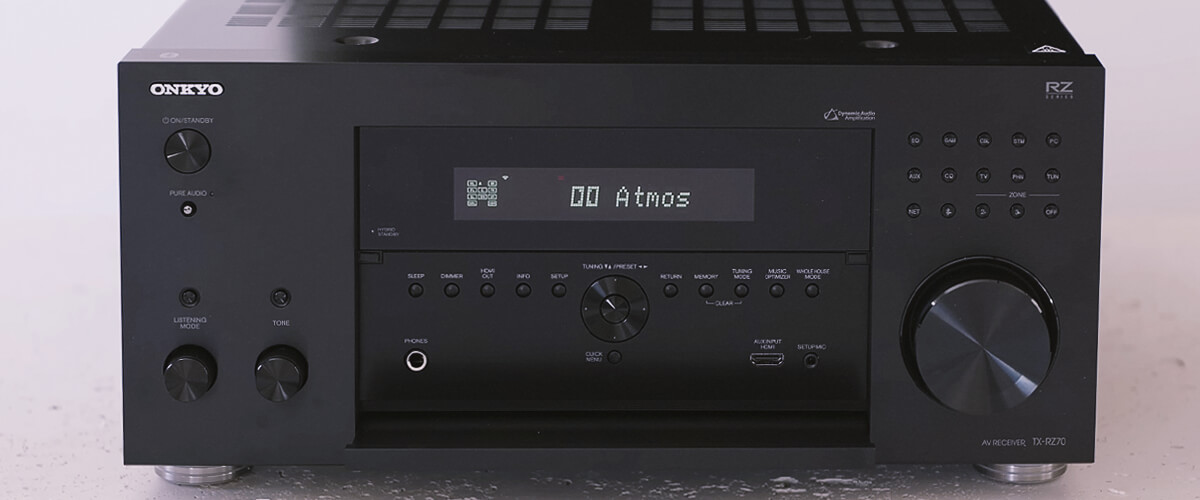
In addition, there are 2 optical and 2 coaxial digital inputs, four analog RCA inputs, a phono stage input, Zone 2/Zone 3 stereo outputs, and that’s not counting the 11 pairs of speaker cable terminals on the rear panel.
During testing, I used a 5.4.2 Atmos configuration with two RZ70 channels feeding two Klipsch wall-mounted subwoofers. When I first turned it on and set up the crossovers, everything sounded good enough, but I didn’t notice anything outstanding. Then I decided to spend some time setting up the Dirac live, and after a number of manipulations, I finally got what I wanted so badly. The sound blew me away! The detailing, as well as the mid-bass, was just insane. The subwoofers worked to their full potential, and I didn’t notice any distortion or interference.
In my opinion, the Onkyo TX-RZ70 is an ideal example of a modern multifunctional device. If you (like me) are a passionate movie buff, love good sound, and want to buy a “friend” for many years, the TX-RZ70 will be the optimal choice.
Specifications of Onkyo TX-SR393
- Channels: 11.2.
- Output power: 140W/8 Ohms.
- HDMI inputs/outputs: 7/3.
- Surround sound
- Dolby features: Dolby TrueHD, Dolby Atmos Height Virtualizer, Dolby Atmos, Dolby Surround upmixing.
- DTS features: DTS HD Master, DTS:X, DTS Neural:X upmixing, DTS Virtual:X.
- Other features: IMAX Enhanced, Dirac Live.
- Video
- Video functions: 4K/120Hz, 8K/60Hz pass-through, upscaling to 8K.
- Video support: HDMI ARC, HDMI eARC, HDMI CEC, HDCP2.3, HLG, HDR10, HDR10+, Dolby Vision.
- Bluetooth/Wi-Fi: yes/yes.
- Streaming service: AirPlay2, Spotify, Deezer, Tidal, Pandora, SiriusXM, Napster, SoundCloud, Amazon Music HD, TuneIn.
Pros
- Breathtaking sound, especially after using Dirac live.
- Expensive and high-quality components (investment not only in sound quality but also in durability).
- Supports all modern surround sound formats.
- TNX certified.
- Compatible with SONOS.
Cons
- During my testing, I did not notice any glaring problems or shortcomings.
Onkyo TX-NR7100
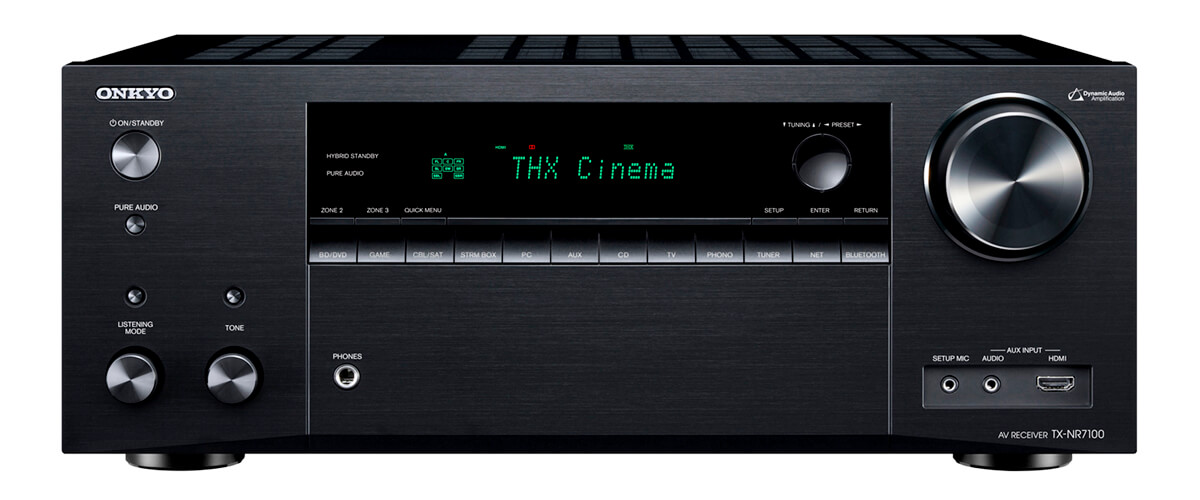
The Onkyo TX-NR7100 is a great mid-range AVR released in 2021. While it may not have the advanced capabilities of some higher-end models (for example, I already noted that the Onkyo TX-RZ50 could be upgraded to an 11.2 configuration), it still offers a great combination of performance and value. This 9.2-channel receiver is suitable for large rooms, delivering a solid 100 watts per channel (8 Ohms, 20Hz – 20kHz, 0.08% THD, 2 ch), less than the TX-RZ50, but I think that’s more than enough for exciting movie viewing.
The TX-NR7100 has many HDMI inputs and outputs: 7 HDMI inputs (1 more than the aforementioned Onkyo TX-RZ50, since it has 1 more on the front) and 2 outputs (eARC). Otherwise, the TX-NR7100’s capabilities are similar to the more expensive RZ50. Its ports also support HDCP 2.3, 4K/120Hz, 8K/60Hz, VRR, ALLM, QMS, and QFT, ensuring compatibility with the latest video and audio formats. So, this unit’s HDMI port options support the latest video formats, including 4K/120Hz and 8K/60Hz pass-through, as well as HDR10, HLG, Dolby Vision and BT.2020.
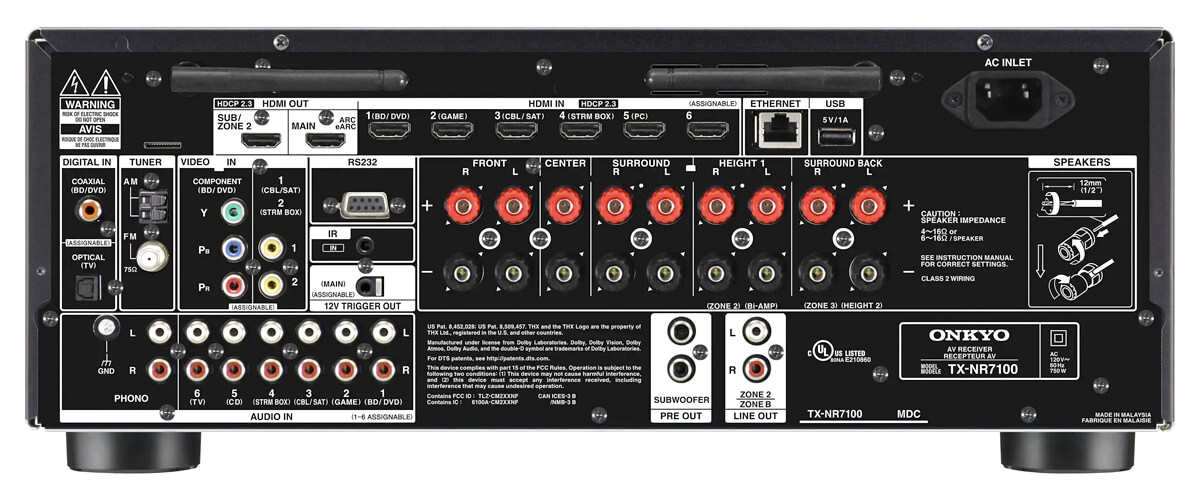
A phono input for turntables is also provided, allowing you to connect your favorite analog source without needing an external preamp.
Well, not to be repetitive, it also has all the wireless connectivity that the TX-RZ50 has, except for working with voice assistants (a device to work with Google or Alexa is sold separately).
Creating 5.2.4-ch/7.2.2-ch configurations with this receiver gives you access to content with Dolby Atmos and DTS:X surround sound formats. In addition, it is equipped with a THX Certified Select Dynamic Audio Amplification system and IMAX Enhanced technologies.
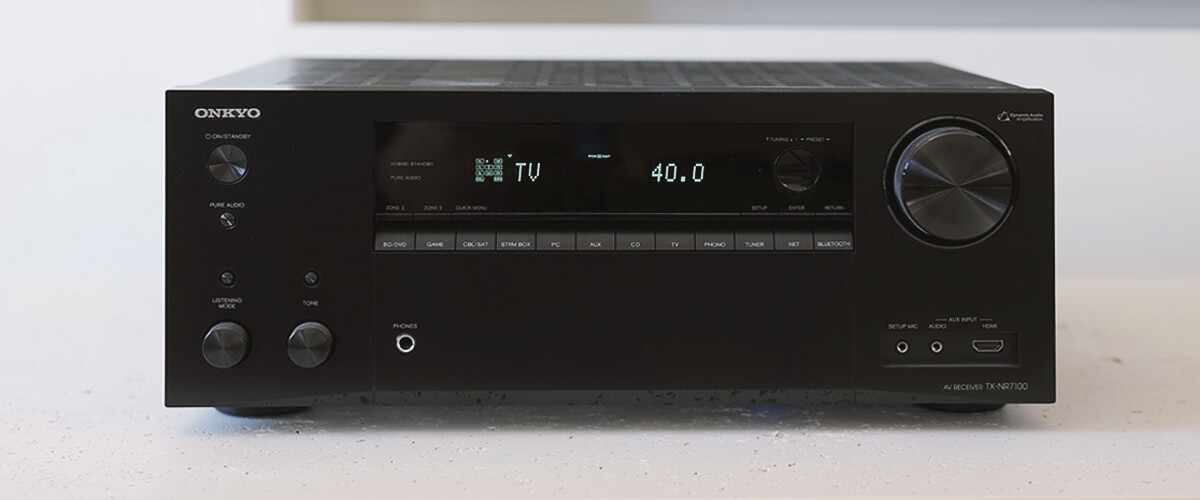
Since I’ve already started comparing the Onkyo TX-NR7100 to the Onkyo TX-RZ50, I’d also note that you won’t run into any setup difficulties with this model because the receiver is equipped with AccuEQ Advance with AccuReflex, which is a simpler Dirac. As far as I’m concerned, it does a great job of calibration. And the icing on the cake is the Multi-Room option for 3 Zones.
I tested the Onkyo TX-NR7100 while watching the cult sci-fi movie Blade Runner. The rich, detailed sound emphasized the atmospheric soundtrack and enhanced the futuristic atmosphere. As for the music, listening to my Gorillaz Now Now record left me pleasantly impressed.
Onkyo TX-NR7100 is a good combination of price and quality without any frills. Only the essentials, including advanced audio and video features. An excellent choice for practical people.
Specifications of Onkyo TX-NR7100
- Channels: 9.2.
- Output power: 100W/8 Ohms.
- HDMI inputs/outputs: 7/2.
- Surround sound
- Dolby features: Dolby TrueHD, Dolby Atmos Height Virtualizer, Dolby Atmos, Dolby Surround.
- DTS features: DTS HD Master, DTS:X, DTS Neural:X.
- IMAX Enhanced.
- Video
- Video functions: 4K/120Hz, 8K/60Hz pass-through, upscaling to 8K.
- Video support: HDMI ARC, HDMI eARC, HDCP2.3, HLG, HDR10, HDR10+, Dolby Vision.
- Bluetooth/Wi-Fi: yes/yes.
- Streaming service: AirPlay2, Spotify, Deezer, Tidal, Pandora, SiriusXM, Napster, SoundCloud, Amazon Music HD, TuneIn.
Pros
- Powerful enough for large rooms.
- Support for the latest surround sound formats and the ability to build various configurations.
- Room calibration technology makes setup convenient and fast.
Cons
- Considering the combination of quality and cost, I did not find them.
Onkyo TX-NR6050

Onkyo home theater receiver is finally on my list! I would say if it wasn’t the fourth model presented here. Still, no kidding, the TX-NR6050 is worth your attention because it offers an affordable price and very good options. The model, like the TX-NR 7100, was released in 2021, which means it’s fair to look at it through comparison.
First, the Onkyo TX-NR6050 is a 7.2-channel receiver, delivering 90W per channel (8-Ohm, 20Hz – 20kHz, 0.08% THD, 2 ch). That’s serious power for thrilling sound, whether watching movies or listening to your favorite tunes, and it will fill the average room to capacity. Comparing it to the TX-NR7100, which is a 9.2-channel receiver, you might think, “Fewer channels? Why should I even consider it?” However, for many users, a 7.2-channel system is more than enough, and you can save a few dollars in the process.

The HDMI ports support HDCP 2.3, 8K/60Hz, 4K/120Hz, and HDR formats, so most of the content available today will be at your disposal. The TX-NR7100 offers slightly more HDMI inputs (6 here), but the number depends on how many devices you’re putting together in your system simultaneously.
The TX-NR6050 and TX-NR7100 support Bluetooth and Wi-Fi, so streaming music from your phone or favorite services is easy.
The receiver supports Dolby Atmos and DTS:X surround sound formats but has no certified technology like its more expensive brothers. But, honestly, I don’t think it plays a big role unless you know the ins and outs of multichannel sound distribution.

The calibration system in the model is the same as in the Onkyo TX-NR7100, but the receiver broadcasts audio for 2 Zones only.
While watching the movie “The Matrix,” Onkyo TX-NR6050 and other models showed high quality. The soundtracks were dynamic and detailed, perfectly conveying the exciting action of the movie and the complex sound design. I heard all the dialog clearly, and the Dolby Atmos added depth and immersion to the movie’s atmosphere.
Onkyo TX-NR6050, in my opinion, will suit not demanding users who nevertheless want to stay in the trend and have a device for years to come. After all, you get access to the latest video and surround sound formats at an affordable price while making compromises with some features.
Specifications of Onkyo TX-NR6050
- Channels: 7.2.
- Output power: 90W/8 Ohms.
- HDMI inputs/outputs: 6/2.
- Surround sound
- Dolby features: Dolby TrueHD, Dolby Atmos Height Virtualizer, Dolby Atmos, Dolby Surround.
- DTS features: DTS HD Master, DTS:X, DTS Neural:X, DTS Virtual:X.
- Video
- Video functions: 4K/120Hz, 8K/60Hz pass-through, upscaling to 8K.
- Video support: HDMI ARC, HDMI eARC, HDCP2.3, HLG, HDR10, HDR10+, Dolby Vision.
- Bluetooth/Wi-Fi: yes/yes.
- Streaming service: AirPlay2, Spotify, Deezer, Tidal, Pandora, SiriusXM, Napster, SoundCloud, Amazon Music HD, TuneIn.
Pros
- Powerful enough (90 watts per channel) for thrilling movie and music sound.
- Good connectivity allows you to view content in high resolution and quality.
- Facilitated room calibration technology.
Cons
- For its category, it’s good; I don’t see any obvious drawbacks.
Onkyo TX-8260 – stereo
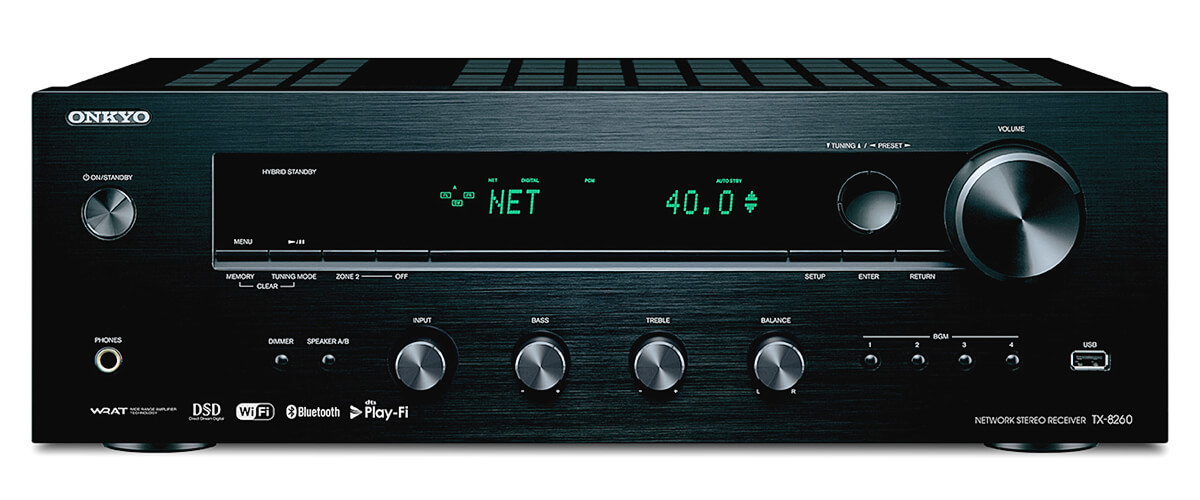
I am an avid audiophile, and my list could not do without the Onkyo stereo receiver, especially since the company released an excellent model at an affordable price in 2017. The Onkyo TX-8260 is a networked stereo receiver designed for traditional and modern audiophiles. I think this model can be a great companion for any music enthusiast, as it combines high-quality sound with a wide range of connectivity options.
The Onkyo TX-8260 has 80 watts of power (8 ohms, 20-20 kHz, 0.1%, 2 Ch). It features Onkyo’s WRAT (Wide Range Amplifier Technology) and a high current low impedance speaker to ensure that your music sounds clear, dynamic, and detailed. It’s also compatible with popular multi-room audio platforms such as Chromecast built-in, DTS Play-Fi, and FlareConnect (which you can control using the Onkyo Controller app for 2 Zones with 5 GHz/2.4 GHz Wi-Fi for stable connection), allowing you to create seamless sound throughout your home. You can also connect your Sonos ecosystem to it. And even though your home won’t shake with the sounds of rock, it’s still good data for daily listening.
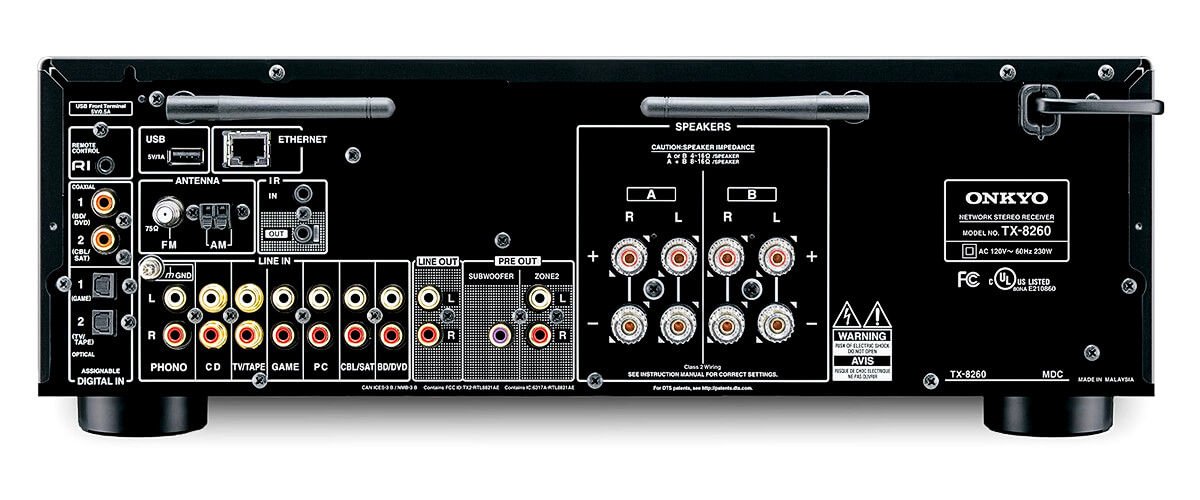
What makes it versatile are the connectivity options, which include my beloved phono input, several analog and digital inputs, USB and Bluetooth, and Wi-Fi wireless options. I’m one of those lazy people who like to control technology from their phones, so I use all the streaming platforms. Do you? If so, the TX-8260 has built-in support for Spotify, TIDAL, Deezer, and TuneIn. And, of course, it will suit Apple fans because it’s compatible with all of the company’s devices. If Android fans have had time to get excited, then in vain, Onkyo TX-8260 will suit you too).
Are you ready to go on a sonic journey? Then I’ll tell you about my listening experience with the Onkyo TX-8260. When I put the needle on the turntable with a Frank Sinatra The Platinum Collection record, it was like I was transported to a recording studio. The warmth and detail of every note were breathtaking, making the songs sound fresh and exciting over and over again.

Then I switched over and explored the world of streaming. I started Spotify and started listening to the Red Hot Chili Peppers’ song Dark Necessities. The breathtaking bass and crisp vocals instantly had me stomping my feet.
The Onkyo TX-8260 is a 2-channel stereo receiver with excellent audio performance and features for its price range. It offers 100 watts per channel, connectivity, and support for Hi-Res Audio formats, making it a good choice for those looking for a good stereo receiver at a reasonable price.
Specifications of Onkyo TX-8260
- Channels: 2.1.
- Output power: 80W/8 Ohms.
- HDMI inputs/outputs: 0/0.
- Surround sound
- Dolby features: Dolby TrueHD, Dolby Atmos Height Virtualizer, Dolby Atmos, Dolby Surround.
- DTS features: DTS HD Master, DTS:X, DTS Neural:X, DTS Virtual:X.
- Video: has not.
- Bluetooth/Wi-Fi: yes/yes.
- Streaming service: AirPlay2, Spotify, Deezer, Tidal, Pandora, SiriusXM, Napster, SoundCloud, Amazon Music HD, TuneIn.
Pros
- Nice playback at high volume.
- Works with multiple streaming platforms.
- Possibility to broadcast audio to 2 Zones.
- Equipped with a phono input.
Cons
- I do not see any significant disadvantages to this rank of stereo receiver.
Key features to look for in Onkyo receivers
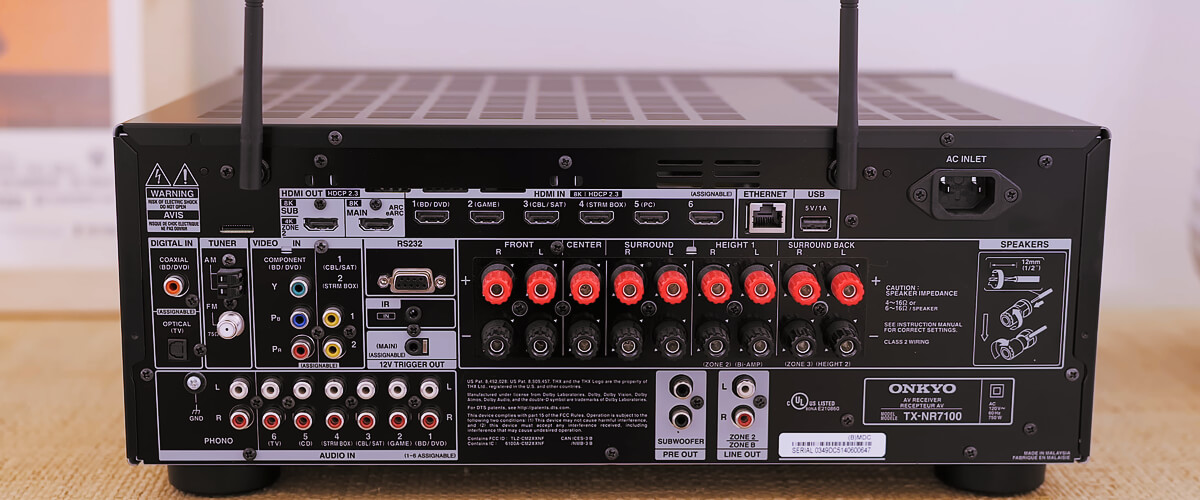
When it comes to choosing an AV receiver, it is important to remember that it is not a trivial task because you are investing a lot of money in a component of your system that should last you for many years. There are many parameters to consider, such as the user’s needs, the room’s size, and the speakers’ configuration. So let me tell you about the most important factors to pay attention to when you are on the threshold of purchasing such an important device.
Audio performance
Although power is not a determining factor to consider, it does play an important role. Whether you’re watching your favorite movie, broadcasting your favorite show, or playing your favorite game, a good receiver will help you feel like you’re in the middle of something. How much power do you really need? On average, for small rooms (15-30 m2), 50-80 watts per channel is sufficient. For fans of shaking windows, you will need higher power, although I prefer the volume quality. But if you decide to “please” the neighbors, ensure your speakers can withstand it, check compatibility before buying, or go broke for new, more powerful ones.
Speaker configurations
So, the right speaker setup can completely change your listening experience. That’s why choosing an AV receiver with the right number of channels is also important to create your desired speaker configuration.
What options do you have? At the most basic level, you have a 5.1 configuration comprising five speakers and a subwoofer. This configuration is ideal for small rooms or those who don’t want to spend much money on a home theater installation.
However, for those who want a more immersive experience, there are more advanced configurations, such as 7.1, 9.1, and even 13.1. These configurations use more speakers to create a more realistic, immersive sound. For example, in a movie where a car rushes by, you’ll hear the sound of the engine going from one speaker to the next, as if it’s literally driving around you.
I recommend going first based on what kind of room and budget you have because, in my experience, the average unsophisticated listener won’t notice a significant difference between close pairs.
Connectivity options
I think it is most important to pay attention to the necessary connection ports and supported formats.
For example, with HDMI, you can transmit high-quality video and audio signals over a single cable, making it easy to connect your TV, Blu-ray player, game console, and other devices to the receiver. Please pay attention to their capabilities: eARC will provide you with higher bandwidth and improved sound quality, and HDCP will prevent unauthorized copying of digital content.
The Phono input is important if you’re an audiophile like me and want to connect a turntable to your receiver to enjoy vinyl records.
Finally, built-in Bluetooth/Wi-Fi and streaming services are becoming increasingly important. You can easily connect your phone, tablet, or other devices to the receiver and listen to music wirelessly. Many modern receivers also have built-in streaming services such as Spotify, Tidal, and Pandora, allowing you to access a wide range of music and other content directly from your receiver. For me, these are important options.
The receivers are also often equipped with inputs for legacy technology (component, coaxial), USB, and outputs to an optional stereo receiver or subwoofer. If you still have questions about connectivity, I recommend you read this article about AV receiver connections.
Video compatibility
When creating a home theater experience, video compatibility is just as important as audio quality. Consider supporting high-quality video formats such as 4K/120Hz, 8K/60Hz, HDR10, Dolby Vision, and HLG, but your TV needs to be ready.
I pay attention to receivers with video scaling and pass-through features. Video scaling features are important because they allow the receiver to take a low-resolution video signal and convert it to a higher resolution, improving the overall picture quality and making your movies and TV shows better than ever. And the pass-through video capabilities allow you to stream video from your device to your TV without losing quality.
Surround sound formats
And what would you do without surround sound? After all, that’s what it’s all about. With the right surround sound format, you can feel like you’re in the middle of the action, with sounds coming from everywhere. So look out for modern surround sound formats like Dolby Atmos, DTS:X, and Auro-3D, as more and more content is being released with these soundtracks today.
Dolby Atmos is one of the most popular surround sound formats widely used in cinemas and home theaters. It uses overhead speakers to create a more immersive sound, with sounds coming from everywhere. DTS:X is another popular surround sound format known for its highest quality. Finally, Auro-3D is a newer format that uses additional speakers to create a more realistic sound.
In conclusion, choosing an AV receiver requires careful consideration of a variety of factors. By taking into account audio performance, speaker configurations, connectivity options, video compatibility, and surround sound formats, you can find the perfect receiver to meet your needs and provide an exceptional home theater experience.

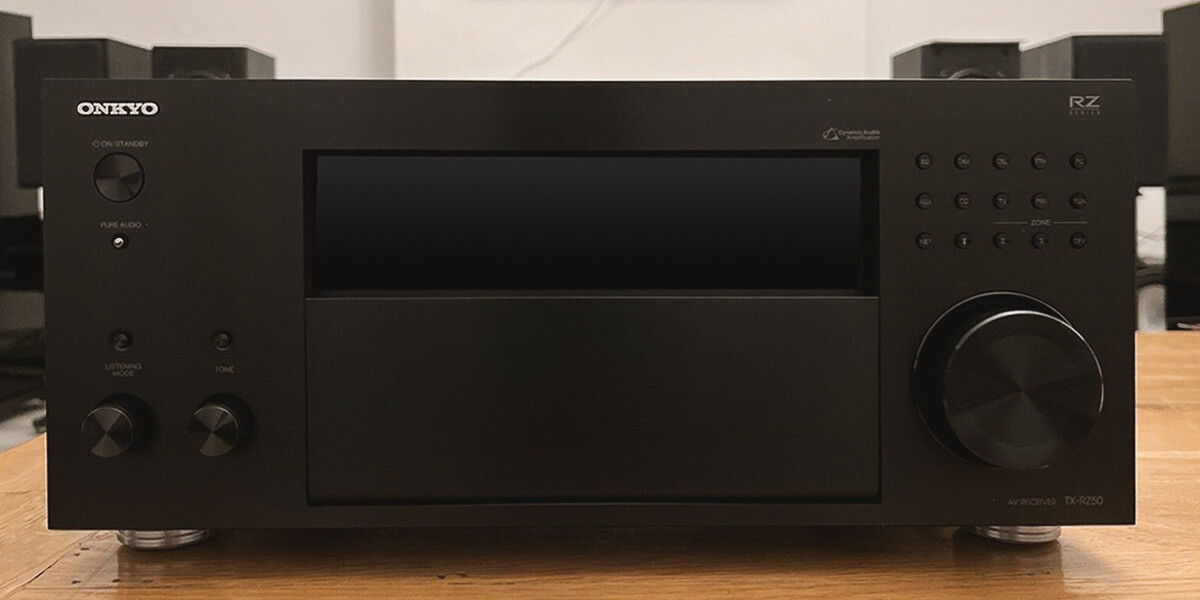


![Best 2-Channel Receiver [Expert Reviews and Buying Guide]](https://hometheaterology.com/wp-content/uploads/2023/11/best-2-channel-receiver-stereo-300x150.jpg)

